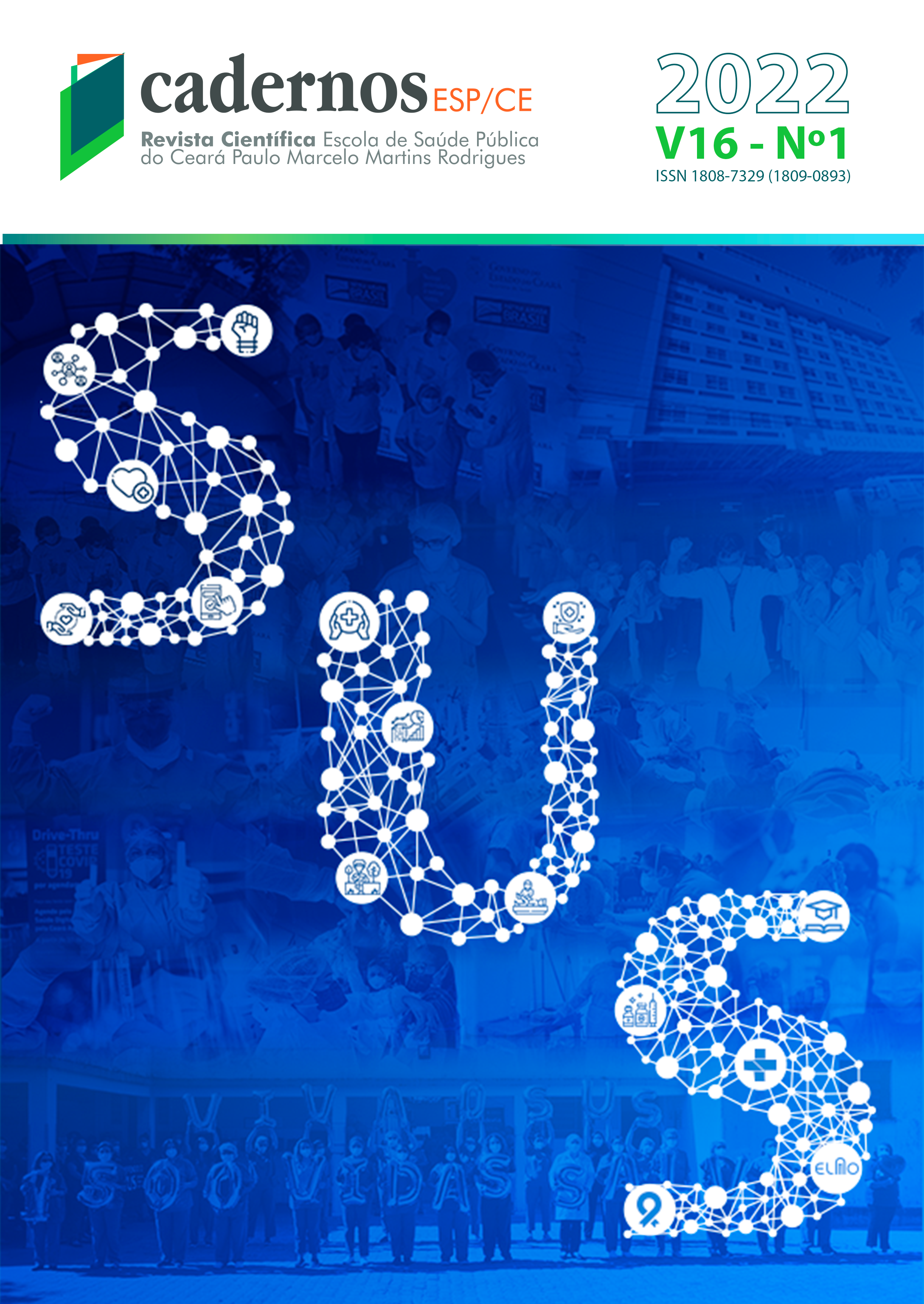PSYCHOANALYTIC ATTENDANCE IN SUBJECTIVE URGENCY
WOMEN IN SITUATIONS OF DOMESTIC VIOLENCE IN TIMES OF COVID-19
DOI:
https://doi.org/10.54620/cadesp.v16i1.578Keywords:
Public Policy, Collective Health, COVID-19, Domestic Violence, PsychoanalysisAbstract
The objective of this article is to analyze the apparatus of clinical-institutional listening in subjective urgency in public policy, with a focus on the psychoanalytic treatment of women (done remotely) in situations of domestic violence during the COVID-19 pandemic. The article discusses a paradigmatic clinical case, which is part of the intervention research project of the Laboratory of the Study of Psychoanalysis, Culture, and Subjectivity (LAEpCUS) at the University of Fortaleza (UNIFOR) in collaboration with the Nucleus for Confronting Violence Against Women (NUDEM), which is associated with the Public Defender of the State of Ceará. It problematizes the complexity of gender-based violence exhibiting the tensions within the vision of a victim/aggressor dichotomy. It concludes that against the backdrop of the coronavirus pandemic, new demands have been imposed on daily life, so that treatments of the mechanism of subjective urgency with women in situations of domestic violence, such as the one illustrated by the clinical case, permit a better positioning of them against their situations of vulnerability and risk. The interfaces between the judiciary and mental health point to successes in dealing with domestic violence
Downloads
References
2. Fórum Brasileiro de Segurança Pública. Anuário Brasileiro de Segurança Pública 2020. 2020, 14. Disponível em: https://forumseguranca.org.br/anuario-brasileiro-seguranca-publica/
3. Belém (PA). Convenção Interamericana para prevenir, punir e erradicar a violência contra a mulher [Internet]. Belém: 1994. Disponível em: http://www.cidh.org/Basicos/Portugues/m.Belem.do.Para.htm.
4. Scott J. Gênero: uma Categoria Útil de Análise Histórica. Educação e Realidade. 1995. 20(2):71-99. Disponível em: https://seer.ufrgs.br/index.php/educacaoerealidade/article/view/71721.
5. Instituto de Pesquisa Econômica Aplicada. Atlas da Violência. Ministério da Economia: IPEA [Internet]; 2020. Disponível em: https://www.ipea.gov.br/atlasviolencia/publicacoes
6. Brasil. Relatório de Atendimento da Casa da Mulher Brasileira. Governo do Estado do Ceará. Fortaleza: 2021.
7. World Health Organization. WHO multi-country study on women's health and domestic violence against women: initial results on prevalence, health outcomes, and women's reponses. 2005. Disponível em: https://www.who.int/reproductivehealth/publications/violence/24159358X/en/
8. Bodiou L, Chauvaud F. Féminicides, féminicides e violences de genre. In Boudiou L, Chauvaud F, Gaussot L. Grihon MJ, Laufer L, Santos B (Org.) Assassinats de femmes. Le féminicide. Histoire et actualités. Paris: Hermann Éditeurs; 2019.
9. Brasília. Resolução nº 011, de 11 de maio de 2018. Regulamenta a prestação de serviços psicológicos realizados por meios de tecnologias da informação e da comunicação e revoga a Resolução CFP nº 11/2012. Conselho Federal de Psicologia [Internet]. 2018. Disponível em: https://e-psi.cfp.org.br/resolucao-cfp-no-11-2018/
10. Brasília. Resolução nº 4, de 26 de março de 2020. Dispõe sobre regulamentação de serviços psicológicos prestados por meio de Tecnologia da Informação e da Comunicação durante a pandemia do COVID-19. Conselho Federal de Psicologia [Internet]. 2020. Disponível em: https://www.in.gov.br/en/web/dou/-/resolucao-n-4-de-26-de-marco-de-2020-250189333
11. Mendonça VD. Atendimento psicológico online no contexto da pandemia de COVID-19. Cadernos ESP [Internet]. 22º de julho de 2020;14(1):74 -79. Disponível em: //cadernos.esp.ce.gov.br/index.php/cadernos/article/view/399
12. Conselho Nacional de Saúde. Resolução nº 466, de 12 de dezembro de 2012. Diário Oficial da União [Internet]. 2012. Disponível em: https://bvsms.saude.gov.br/bvs/saudelegis/cns/2013/res0466_12_12_2012.html
13. Conselho Nacional de Saúde. Resolução nº 510, de 1 de abril de 2016. Diário Oficial da União [Internet]. 2016. Disponível em: https://bvsms.saude.gov.br/bvs/saudelegis/cns/2016/res0510_07_04_2016.html
14. Maron G. Urgência sem emergência? In: Maron G, Borsoi P (Org.). Urgência sem emergência? . Rio de Janeiro: Subversos, 2012. p. 14-28
15. Simões FLC. Clínica da urgência subjetiva: efeitos da psicanálise em um prontoatendimento [dissertação]. Belo Horizonte: Pontifícia Universidade Católica de Minas Gerais; 2011. 101 p.
16. Caplan G. Princípios de psiquiatria preventiva. Rio de Janeiro: Editora Paidos; 1980.
17. Rodrigues JA, Dassoler VA, Cherer, EQ. A aplicabilidade do dispositivo clínico-institucional urgência subjetiva no tratamento da toxicomania. Mental [Internet]. 2012 jun;10(18) Disponível em: http://pepsic.bvsalud.org/scielo.php?script=sci_arttext&pid=S1679-44272012000100005
18. Ministério da Educação (BR). Rede Humaniza SUS. Governo do Brasil [Internet]. 2020. Disponível em: https://www.gov.br/ebserh/pt-br/hospitais-universitarios/regiao-sudeste/hc-ufu/comunicacao/noticias/rede-humaniza-sus
19. Kruszel L. Esclarecer a função da psicanálise. In: Harari A, Cardenas MH, Fruger F (Org.). Os usos da psicanálise: primeiro encontro americano do Campo Freudiano. Rio de Janeiro: Contra Capa Livraria; 2003. p. 63- 96.
20. Cerruti MQ, Rosa MD. Em busca de novas abordagens para a violência de gênero: a desconstrução da vítima. Revista Mal-Estar e Subjetividade [Internet]. 2008; VIII(4): 1047-1076. Disponível em: https://periodicos.unifor.br/rmes/article/view/4897
Downloads
Published
How to Cite
Conference Proceedings Volume
Section
License
Copyright (c) 2022 Cadernos ESP

This work is licensed under a Creative Commons Attribution 4.0 International License.
Accepted 2021-07-12
Published 2022-03-03























